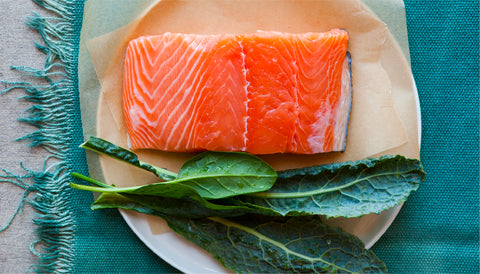Quarantine Habits: How Have Food Preferences Changed?

Thanks to COVID-19, there have been many changes to our daily routines since March 2020, and our eating habits are no exception. As the world went into lockdown to slow the spread of the novel coronavirus, many people experienced increased levels of stress and uncertainty as our usual routines were disrupted. Grocery stores seemed to be draining of supplies quickly as people rushed to stockpile items at the beginning of the lockdown, and more people experienced food insecurity due to financial strain. Now, more than a year after all of this began, it is interesting to see how our eating habits, as well as our meal planning and food choices, have shifted as a result of COVID-19. Despite the uncertainty and stress, many Americans have adopted new hobbies and are enjoying cooking from home.
1. Grocery shopping

Our food consumption during COVID-19 experienced a shift as restaurants closed or switched to delivery-only models and many people started to feel uncomfortable with being around crowds. Online grocery ordering, which was already on the rise prior to the pandemic, experienced a substantial increase amid the lockdown. Forbes reported that a year prior to the pandemic, 81% of Americans had never ordered their groceries online, compared with the 79% of Americans using online platforms as of December 2020.1 Here are a few more statistics that Forbes reported:
- Online grocery sales increased by $6 billion between August 2019 and June 2020.1
- In the year between March 2019 and March 2020, there was a 30% increase in the amount of money spent on groceries per household per month, as consumers shifted from eating out to depending on having more food available in their own households.1
- More and more consumers are wanting a quick shopping experience, and stores have adapted to this desire by offering more contactless payment options to make it faster to check out.1
2. Cooking

With fewer people eating out and many workers having more flexible schedules thanks to remote work options, more Americans have been cooking their meals at home. According to a survey of 1,005 adult Americans, 54% reported that they were doing more cooking at home, and 46% reported that they were doing more baking.2 A study conducted in Spain found that prior to the pandemic, homemade baked goods had been among the least-consumed foods, but they experienced a significant jump in consumption during quarantine.3 Check out some of these additional statistics on cooking during the pandemic:
- Half of the individuals who participated in the survey mentioned above reported that they feel more confident in the kitchen now than they did pre-pandemic.2
- Many Americans expressed an increased interest in trying new foods (45%) and in seeking out new ingredients (44%) during the pandemic.2
- Google search trends showed a significant spike in searches for online cooking classes as Americans tried out new recipes and picked up new hobbies during the quarantine.
- Many Americans decided to turn to books for suggestions about meals and snacks, and two cookbooks made Amazon’s bestseller list for 2020.
3. Family-centric meals

With more flexible work schedules eliminating the commute to and from work for many employees, as well as changes in school and extracurricular activities for younger Americans, many people have taken to setting the table and having more sit-down family meals. A survey of 1,000 American adults by the FMI Foundation in August 2020 found that 75% of participants reported having the same number of — or more — family meals during quarantine than they had before.4 Of those respondents, 71% reported that eating family meals makes them feel more connected to their family members, and 33% reported that they believe they eat a more balanced, varied diet when they eat together as opposed to eating alone.4 These results show that, despite uncertain times, many Americans are adopting healthy eating habits during COVID-19. Due to limitations on travel and gatherings, many families and friends have been getting creative and holding virtual meals with their loved ones. Time together can be a very important aspect of stress management, and this coping mechanism is just one of many that Americans have adopted over the past year.
4. Food choices

Several studies have been conducted to determine the differences between our food choices pre-pandemic versus our choices now. With all of the uncertainty brought on by COVID-19, many Americans found comfort in old recipes, while others tried new ingredients and enjoyed sampling new snacks and eating healthy. One survey of residents of Phoenix, Arizona, and Detroit, Michigan, found that 47% of respondents reported buying more food in general at the grocery store — with purchases of fresh produce and dairy notably increasing, especially in households with children.5 Many Americans are embracing nutritious diets, as evidenced by this increase in the amount of fresh fruits and vegetables purchased. Additionally, 21% of respondents reported eating more throughout the day than they did pre-pandemic, with a particular increase in snack consumption.5 Regardless of how your eating habits have changed in the midst of COVID-19, remember: There are no expectations for how you should adapt to living through a pandemic. Just focus on taking care of yourself!
5. Food insecurity

The start of the pandemic and the subsequent lockdown brought about uncertainty regarding food access and supply for many Americans. With many facing unemployment or decreased hours at work, Feeding America estimated that around one in seven Americans may have experienced food insecurity, or a lack of reliable or consistent access to nutritious and affordable food, in 2020.6 Currently, Feeding America projects that this will improve slightly in 2021.6 If food insecurity has affected you or someone you know, reach out to your healthcare provider, as there are many services and programs available to assist you during this time.
Final thoughts
It is no surprise that our food habits and relationships with food have changed since the onset of COVID-19 and the quarantine. Massive shifts in our daily routines, exacerbated by global uncertainty, resulted in stress that led to the stockpiling of groceries and increased food insecurity. As the quarantine went on, some individuals were able to relieve stress by adopting new hobbies, leading to an increase in people cooking at home and trying new ingredients and recipes. Our social circumstances shifted, and many Americans got creative and still held family dinners, albeit virtually. Some quarantine habits may persist post-pandemic, as many individuals report that they will likely continue to cook more often and do their grocery shopping online; quicker in-person shopping experiences may become another preferred way of purchasing food.
Now, more than one year since the onset of the quarantine, as some things slowly start to return to normal, maybe some habits you adopted during the pandemic are here to stay. You may have discovered new ingredients or hobbies that helped you get in touch with your creative side; you may also have enjoyed an increase in family dinners or new ways of grocery shopping. As some countries, such as the United States, Israel and Britain, continue providing vaccines and begin to open their doors, we may see an increase in social eating by friends and families who were only able to meet virtually over the past year.7 Regardless of how your lifestyle has changed, it is important to be good to yourself during these stressful times by finding some sustainable lifestyle habits that are kind to your body and bring you joy.
[1] Morgan, B. (2021, February 18). 3 lasting changes to grocery shopping AFTER COVID-19. Retrieved March 13, 2021, from https://www.forbes.com/sites/blakemorgan/2020/12/14/3-lasting-changes-to-grocery-shopping-after-covid-19/?sh=4ede4afb54e7
[2] Hunter food Study special report. (2020, April 9). Retrieved March 13, 2021, from https://www.hunterpr.com/foodstudy_coronavirus/
[3] Sánchez-Sánchez, E., Ramírez-Vargas, G., Avellaneda-López, Y., Orellana-Pecino, J. I., García-Marín, E., & Díaz-Jimenez, J. (2020). Eating Habits and Physical Activity of the Spanish Population during the COVID-19 Pandemic Period. Nutrients, 12(9), 2826. https://doi.org/10.3390/nu12092826
[4] FMI Foundation. (2020, September 01). Americans are staying strong with family meals during the Pandemic – and plan to do so after. Retrieved March 13, 2021, from https://www.fmi.org/newsroom/news-archive/view/2020/09/01/americans-are-staying-strong-with-family-meals-during-the-pandemic-and-plan-to-do-so-after
[5] Chenarides, L., Grebitus, C., Lusk, J.L., and Printezis, I. (2020). Food consumption behavior during the COVID-19 pandemic. Agribusiness, 37(1), 44-81. https://doi.org/10.1002/agr.21679
[6] Feeding America. (2021, March). The Impact of the Coronavirus on Food Insecurity During 2020 & 2021. Retrieved March 13, 2021, from https://www.feedingamerica.org/sites/default/files/2021-03/National%20Projections%20Brief_3.9.2021_0.pdf
[7] Turkewitz, J., & Bengali, S. (2021, July 6). A Return to Normal? Not for Countries With Covid Surges and Few Vaccines. The New York Times. https://www.nytimes.com/2021/06/02/world/americas/virus-surges-vaccines.html

